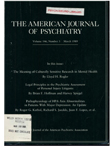Hallucinations: theoretical and clinical overview
Abstract
The authors review the literature on hallucinations; provide theoretical background on these phenomena from physiological, biochemical, and psychological points of view; and discuss the presentations of hallucinations in different diagnostic categories. The longstanding notion that hallucinations are to be equated with schizophrenia, they conclude, is clearly unfounded, and hallucinations are never pathognomonic of any given disorder but can be relatively specific for some conditions. Current knowledge and methods of research have produced no single mechanism to account for the etiology or pathogenesis of hallucinations. The authors present an integrated approach toward viewing the etiology and clinical presentation of hallucinations that involves concepts of biological vulnerability and psychological influences.
Access content
To read the fulltext, please use one of the options below to sign in or purchase access.- Personal login
- Institutional Login
- Sign in via OpenAthens
- Register for access
-
Please login/register if you wish to pair your device and check access availability.
Not a subscriber?
PsychiatryOnline subscription options offer access to the DSM-5 library, books, journals, CME, and patient resources. This all-in-one virtual library provides psychiatrists and mental health professionals with key resources for diagnosis, treatment, research, and professional development.
Need more help? PsychiatryOnline Customer Service may be reached by emailing [email protected] or by calling 800-368-5777 (in the U.S.) or 703-907-7322 (outside the U.S.).



